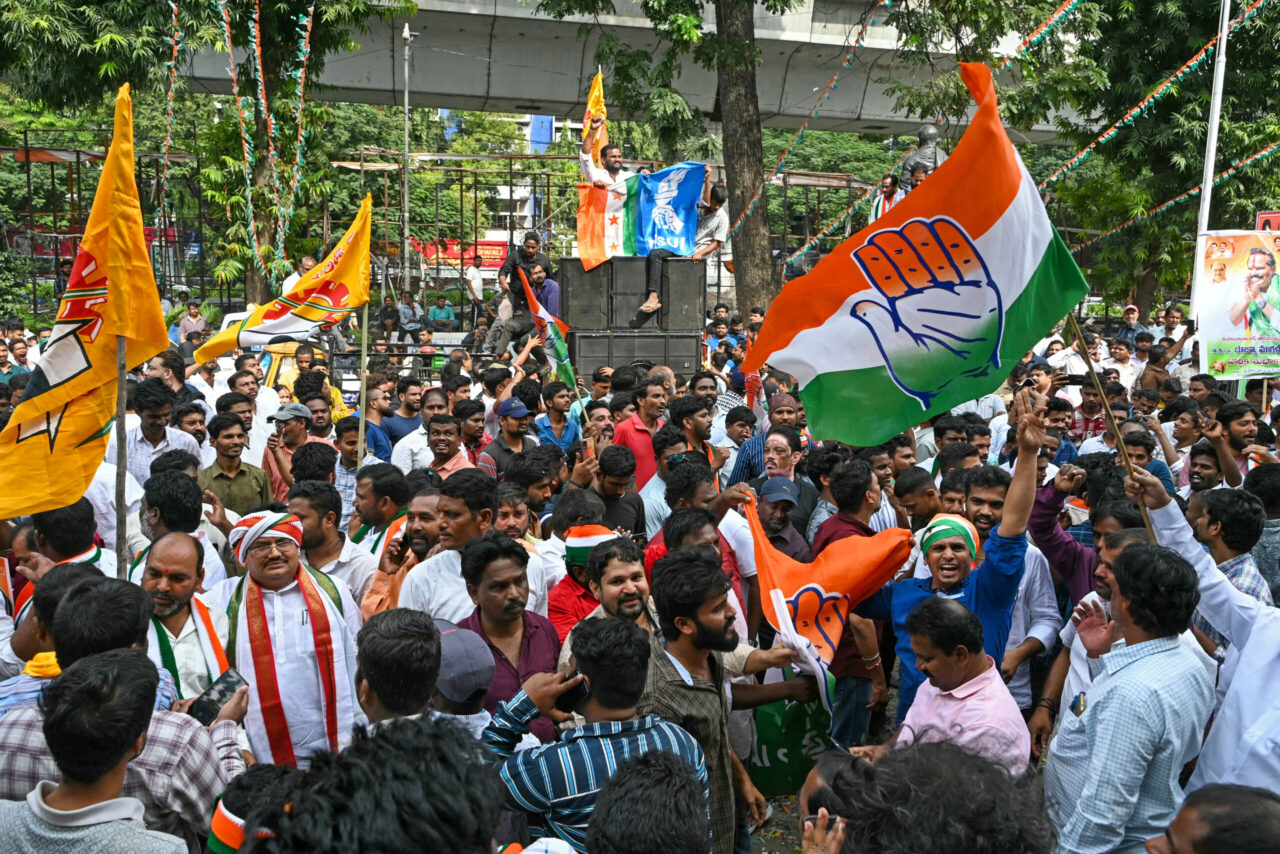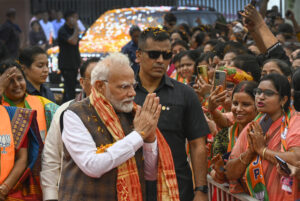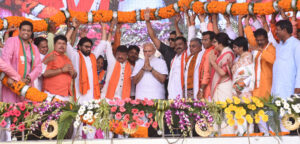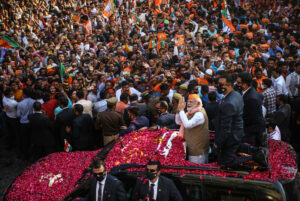
India just held five state elections that did more than declare winners and losers: They offered a roadmap for how to win the national contest in the world’s most populous democracy.
By Rahul Mukherji, Harsh Mander, and Seyed Hossein Zarhani
December 2023
In November, India held five state-assembly elections. Although far short of a national election, upward of 160 million voters flocked to the polls. Little appreciated outside the country, these were in fact probably the most consequential contests to take place anywhere in the final months of 2023. They also offer critical lessons for India’s political opposition at a moment when the stakes could not be higher: Between April and May next year, Indians will go to the polls to choose their country’s national leadership. Will voters give Prime Minister Narendra Modi and his Hindu-nationalist Bharatiya Janata Party (BJP) a third term in power, or will the opposition, led by the Indian National Congress, manage to persuade citizens of the world’s most populous country that they will have a better, safer, and freer future in its hands? Some experts contend that Indian democracy itself is on the ballot.
The May 2023 assembly elections in Karnataka, the only southern state that the BJP had controlled, may provide a roadmap of sorts. Congress won that contest in a landslide, despite Modi himself campaigning in person on behalf of the BJP. Congress pulled off the stunning upset by following a smart and simple strategy: It had in place strong, charismatic state-level leaders who had the full backing of the central party leadership. It presented a clear platform focused on secularism and welfare programming that would benefit voters. And it unified and worked closely with vast swathes of civil society opposed to ethnic nationalism and majoritarianism, presenting a unified front alongside other opposition parties as well.
When the results of the November state-assembly elections were finally announced on December 4, the Congress party had fared far worse. It won only one state, Telangana, and lost control to the BJP in two others, Rajasthan and Chhattisgarh. The BJP also won Madhya Pradesh. The Zoram People’s Movement prevailed in Mizoram.
While it is true that Indian democracy at the national level is not as vibrant or competitive as it once was, and its playing field is far from even, the political opposition still has a chance to win nationally in 2024. But this could be its last chance. If it fails, already compromised state institutions such as the Electoral Commission and Supreme Court may become fully captured; the Muslim minority may become even less safe; and the media and civil society, even more restricted.
Congress’s lone November victory and its defeats equally confirm that the Karnataka strategy is the winning one. The party fully followed that roadmap in Telangana, beginning with the central party’s support of a strong and capable state leader: Anmula Revanth Reddy. Major national Congress leaders such as Rahul Gandhi and his sister Priyanka, who leads the party in Uttar Pradesh, attended huge political rallies in Telangana at Reddy’s invitation. He also accepted the guidance of Rahul Gandhi’s trusted aid, Sunil Kanugolu, who was integral to the party’s victory in Karnataka.
Reddy campaigned on secular and progressive ideals. He visited both temples and mosques, and he promised to provide substantial benefits to all minority communities, with a dedicated sum of US$475 million for minority development. The party also presented a wide-ranging welfare program, as it had in Karnataka, aimed at women, young and elderly people, and minority communities. Finally, Reddy and his party campaigned strategically, coordinating not only with the rest of the INDIA (Indian National Development Inclusive Alliance) coalition but also with civil society organizations.
In the end, Congress increased its vote share in Telangana by 11 percent and secured 64 seats. The incumbent Bharat Rashtra Samithi party won 37 seats, and the BJP just 8.
Going Off-Script
If Reddy and the Telangana Congress party followed the Karnataka roadmap to a T, the state parties in Madhya Pradesh, Rajasthan, and Chhattisgarh threw it in the bin.
In Madhya Pradesh, Congress president Kamal Nath refused to accept Kanugolu’s advice, despite the central party’s urging, and shirked a valuable seat-sharing arrangement with the Samajwadi Party, an INDIA member. Nath also had open differences with another senior Congress leader, former Madhya Pradesh chief minister Digvijay Singh, which the BJP exploited. Finally, Nath and the party rejected a secularist approach, instead offering a soft version of Hindu nationalism — he even endorsed India’s status as a Hindu nation — in hopes of siphoning BJP votes.
This strategy earned Congress its worst results in a decade: It secured just 66 seats compared with 163 for the incumbent BJP, which did not have high approval ratings going into the election.
Congress’s loss in Chhattisgarh, where it was the incumbent, came as a bigger surprise, as its pre-election approval ratings were high. Chief Minister Bhupesh Baghel, like Nath, campaigned on a soft Hindu-nationalist narrative, promoting pilgrimages and festivities associated with the Indian deity Rama. Baghel largely ignored his deputy chief minister, T.S. Singh Deo, who was brought in six months before the elections and wields significant influence in the greatly neglected tribal areas. The party registered significant losses in those areas and came in a distant second to the BJP with a dismal 35 seats.
In Rajasthan, meanwhile, Congress could not overcome strong anti-incumbent sentiment (in part over high levels of corruption in the legislature), despite making a significant welfare pledge. Making matters worse, Chief Minister Ashok Gehlot snubbed Kanugolu’s advice, and the central leadership failed to resolve a feud between Gehlot and another powerful Congress leader, Sachin Pilot, who belongs to the Gurjar community (one of the lower caste groups). Like Nath and Baghel, Gehlot made Hindu-nationalist appeals, though somewhat more subtly, rather than taking a clear secular position. Congress lost significant support in the state’s Gurjar areas and again came in a distant second with just 69 seats to the BJP’s 115.
The lessons for the opposition in 2024 from the last six state elections are the same, regardless of which party won or lost, and they are simple: The opposition must have strong, assured, and focused leadership. It must embrace secularism, not Hindu nationalism, and offer a plan that serves and protects all Indians, regardless of religion, caste, or ethnicity. And, finally, it must set aside party and organizational interests and stand united. This is a proven strategy and likely the country’s last and best defense against the rise of a one-party regime.
Rahul Mukherji is professor and head of the Department of Political Science in the South Asia Institute (SAI) at Heidelberg University in Heidelberg, Germany. Harsh Mander is chairperson of the Centre for Equity Studies in New Delhi, India. Seyed Hossein Zarhani is lecturer and research fellow in SAI’s Department of Political Science at Heidelberg University.
Copyright © 2023 National Endowment for Democracy
Image Credit: Noah Seelam/AFP via Getty Images
| FURTHER READING | ||

Hindu Nationalism and the New Jim CrowAshutosh Varshney and Connor Staggs While the histories of white supremacy and Hindu supremacy are different, their political objectives are much the same. The BJP is forging a regime of exclusion and oppression as brutal as the Jim Crow South. Only India’s voters can reverse its advance. |

How India’s Ruling Party Erodes DemocracyThe BJP has won two successive national elections, but it refuses to respect the rights of Muslims. Is democracy on a collision course with liberalism? |

Why India’s Political Elites Are to BlameIndia has a long history of elites acting undemocratically. But the current government’s attacks on the media, arrests of opposition, and discriminatory laws are deeper and more alarming. |
